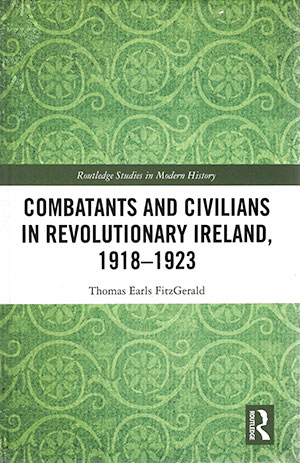 THOMAS EARLS FITZGERALD
THOMAS EARLS FITZGERALD
Routledge
£120
ISBN 9780367333522
Reviewed by Mary McAuliffe
Thomas Earls Fitzgerald has produced the latest in a very welcome series of publications of new research on the Irish War of Independence and Civil War, in this case concentrating on the period in County Kerry. This book is a meticulously researched, closely analysed history of the intimidation and violence directed at civilians by combatants on all sides. This final part is of particular interest as the Civil War was remarkably vicious in Kerry, with massacres committed by both the anti-Treaty IRA and the National Army. In his opening chapters, Earls Fitzgerald locates his research within recent revolutionary historiography, and displays a firm knowledge of the importance and influences of previous works on the period, especially those that looked through the prism of county histories. Due acknowledgement is paid to Peter Hart’s The IRA and its enemies: violence and community in Cork and the precedent it has set for scholars looking at revolutionary violence and intimidation—including, of course, Earls Fitzgerald himself. He also uses a comparative transnational approach with which to view the revolution in Ireland, a welcome change to the exceptionalist slant sometimes seen in revolutionary histories. Post-war Europe was awash with revolutions, many of which were much more violent than the Irish wars.
Divided into seven chapters, the book looks closely at policing, violence and intimidation in Kerry from 1919 and the outbreak of the War of Independence to 1923 and the petering out of the Civil War. The chapter on Republican policing in 1920, which argues that the IRA’s desire was for ‘respectability and decency’, is fascinating. The policies of shutting down land agitation and demonstrating that they were ‘in favour of established landownership’, the enforcing of pub licensing laws, and the harassment and removal of Travellers demonstrate, the author argues, that the IRA represented what was a ‘deferential and conformist’ society, which they did not wish to fundamentally alter. The most conservative of revolutionaries indeed!
The Black and Tans and Auxiliaries were deployed to the county in the late summer of 1920, and a pronounced increase in violent raids and reprisals marked their arrival. This violence was directed at IRA men and their families, but most often it was directed, indiscriminately, at civilians, many of whom were not any substantive threat to British troops, the RIC or the Black and Tans. Reprisal become a more focused weapon into 1921 when Crown forces shut down marts and fairs and burnt creameries, affecting the economic life of the people. Interestingly, reports of reprisals often indicate that the violent behaviour of Crown forces was fuelled by large quantities of looted alcohol. Earls Fitzgerald does not allow Crown force violence because of heavy drinking a pass, however—this was a deliberate, sustained and intensely violent campaign against an unarmed civilian population.
IRA violence, although less intense and sustained, had an impact, albeit uneven, throughout the county as well. While in 1920 the major work of the IRA was ‘preventing civilian–RIC interaction’ and enforcing the boycott of the policing, judicial and legislative arms of the British state, by 1921 the violence of the Crown forces drove men to go ‘on the run’ and the conflict became more ‘militarised and lethal’. Earls Fitzgerald is at pains to point out that the dynamics of IRA violence changed with the arrival of the Black and Tans in July 1920; their method of reprisal directly escalated IRA violence from the autumn of 1920. While IRA ambushes, assassinations and targeted killings of suspected spies and informers in no way reached the proportions of the war in Cork, the trauma and tragedy of many of these were equally evident. The memory of such events is also looked at and there is a very interesting discussion on the execution of Sir Arthur Vicars, during an IRA raid on his home in April 1921, as a spy. Testimonies of what happened, who did what and why, the discrepancies that emerge and how narratives are sometimes deliberately constructed for personal and political reasons are looked at in detail.
Chapter 7 deals with the brutal and traumatic impacts of the Civil War in Kerry. This, however, is the shortest chapter and perhaps needed more time and space. Despite this, Earls Fitzgerald deals with the impact of both ‘Irregular’ violence and that of the National Army on civilians. He highlights the so-called ‘Kenmare case’, where the daughters of a local doctor were assaulted by the officers of the National Army on the night of 2 June 1923. The fallout from this case reverberated high up the chain of command of the Irish Free State, with justice minister Kevin O’Higgins threatening to resign, and demonstrated that ‘some combatants had gone through a process which resulted in lowered inhibitions and produced meaningless violence against the innocent’. The length of the chapter is a minor quibble, however, as the author of this engaging, thought-provoking work certainly succeeds in his aim of ‘looking at those who suffered’ by focusing on the impacts of violence, especially those impacts on unarmed and often innocent civilians, during the period. A highly recommended and a welcome and necessary addition to the historiography of the Irish revolutionary period.
Mary McAuliffe is a Director of the Gender Studies Programme at University College Dublin and author of Margaret Skinnider (UCD Press, 2020).
